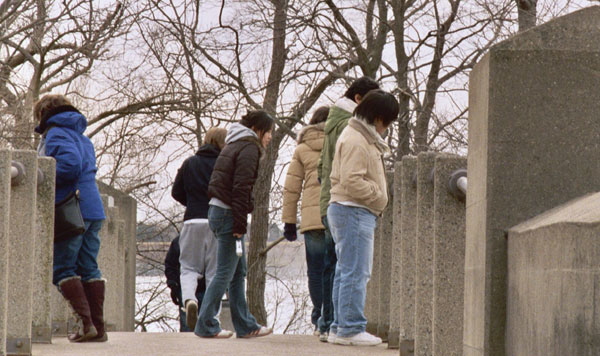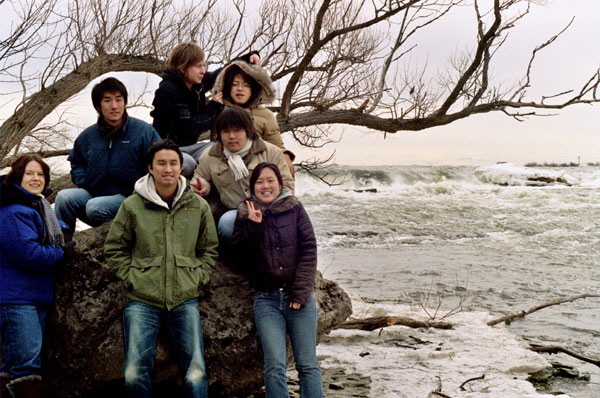|
|
|||||
|
|
|||||
|
Counter added Sunday, March 25, 2007 -11:00 am Pacific Time
|
|||||
|
|
|
Falls Observers
Students from far off check out the place - |
 |
 |
|
Photos and Text, Copyright © 2007 - V. W. Hope, all rights reserved See also The Ice Storm (five sequential pages) and Valentine Snow. |
|||||
|
Niagara Falls is a set of massive waterfalls located on the Niagara River in eastern North America, on the border between the United States and Canada. Niagara Falls (French: les Chutes du Niagara) comprises three separate waterfalls: the Horseshoe Falls (Canadian Falls), the American Falls, and the smaller, adjacent Bridal Veil Falls. ... The Falls formed after the receding of the glaciers of the most recent Ice Age, as water from the newly formed Great Lakes carved a path through the Niagara Escarpment en route to the Atlantic Ocean. While not exceptionally high, Niagara Falls is very wide. With more than 6 million cubic feet (168,000 m³) of water falling over the crestline every minute in high flow, and almost 4 million cubic feet (110,000 m³) on average, it is the most powerful waterfall in North America. ... The original Niagara Falls were near the sites of present-day Queenston, Ontario, Canada, and Lewiston, New York, but erosion of their crest has caused the waterfalls to retreat several kilometres southward. Just upstream from the Falls' current location, Goat Island splits the course of the Niagara River, resulting in the separation of the Canadian Horseshoe Falls to the west from the American and Bridal Veil Falls to the east. Although erosion and recession have been slowed in this century by engineering, the falls will eventually recede far enough to drain most of Lake Erie, the bottom of which is higher than the bottom of the falls. Engineers are working to reduce the rate of erosion to retard this event as long as possible. ... The name "Niagara" is said to originate from an Iroquois word "Onguiaahra" meaning "The Strait." The region's original inhabitants were the Ongiara, an Iroquois tribe named the Neutrals by French settlers, who found them helpful in mediating disputes with other tribes. Native American legend tells of Lelawala, a beautiful maid betrothed by her father to a brave she despised. Rather than marry, Lelawala chose to sacrifice herself to her true love He-No, the Thunder God, who dwelt in a cave behind the Horseshoe Falls. She paddled her canoe into the swift current of the Niagara River and was swept over the brink. He-No caught her as she plummeted, and together their spirits are said to live forever in the Thunder God's sanctuary behind the Falls. ... During the 18th century tourism became popular, and it was the area's main industry by mid-century. Napoleon Bonaparte's brother Jérôme visited with his bride in the early 19th century. ... In October 1829, Sam Patch, who called himself The Yankee Leaper, jumped over the Horseshoe Falls and became the first known person to survive the plunge. This began a long tradition of daredevils trying to go over the Falls and survive. In 1901, 46-year-old Annie Edson Taylor was the first person to go over the Falls in a barrel; she survived virtually unharmed. Soon after exiting the barrel, she said, "No one should ever try that again." Since Taylor's historic ride, 14 other people have intentionally gone over the Falls in or on a device, despite her advice. Some have survived unharmed, but others have drowned or been severely injured. Survivors of such stunts face charges and stiff fines, as it is illegal, on both sides of the border, to attempt to go over the Falls. Other daredevils have made crossing the Falls their goal, starting with the successful passage by Jean François "Blondin" Gravelet in 1859. These tightrope walkers drew huge crowds to witness their exploits. Their wires ran across the gorge, near the current Rainbow Bridge, not over the waterfall itself. Among the many was Ontario's William Hunt, who billed himself as "Signor Fanini" and competed with Blondin in performing outrageous stunts over the gorge. Englishman Captain Matthew Webb, the first man to swim the English Channel, drowned in 1883 after unsuccessfully trying to swim across the whirlpools and rapids downriver from the Falls with nine other people. Two others drowned with him, and the other seven gave up before finishing their course. ... The Maid of the Mist cruises, named for an ancient Ongiara Indian mythical character, have carried passengers into the whirlpools beneath the Falls since 1846. The Whirlpool Aero Car, built in 1916 from a design by Spanish engineer Leonardo Torres y Quevedo, is a cable car which takes passengers over the whirlpool on the Canadian side. And that skips all the geology. |
| [Falls Observers] |
|
All text and photos, unless otherwise noted, Copyright © 2003, 2004, 2005, 2006, 2007, 2008, 2009, 2010 - Alan M. Pavlik |
